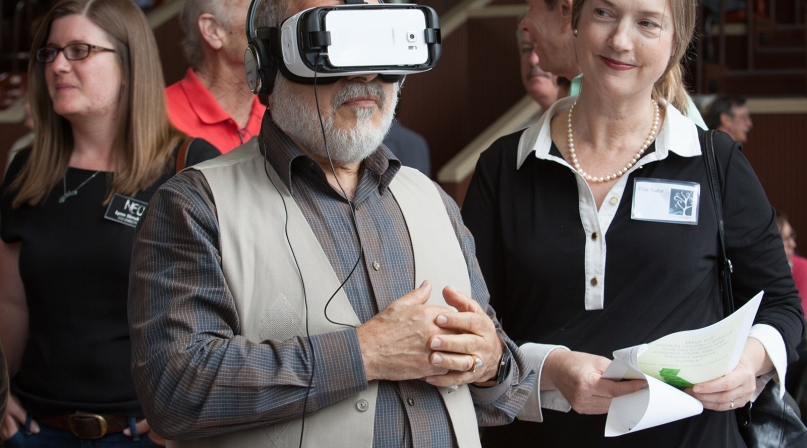In California, Nevada County sees virtual greener pastures ahead
Upcoming Events
Related News

An unidentified man at Nevada County Economic Resource Council’s April 7 economic development summit tries out virtual reality via a smartphone attached to goggles. Photo courtesy of Nevada County ERC Thanks to virtual reality, rural @NCGov punches above its weight when it comes to the presence of digital media firms
When the new Jason Bourne movie hits theaters this summer, think of Nevada County, Calif.
That’s where the technology used for the still-untitled film’s aerial shots was developed and manufactured at Gyro-Stabilized Systems.
The company is one of the first occupants of the Green Screen Institute, a county-supported technology accelerator, that aims to transform this rural county in the Sierra Nevada foothills into a hotbed of virtual- and augmented-reality companies.
“We’re in this little area that some people call Video Valley, the Grass Valley area,” said Jason Fountaine, Gyro-Stabilized Systems’ managing director, in a nod to the area’s history as home to broadcast- and media-related companies, dating back to the 1950s (see sidebar, page 6).
The Green Screen Institute is the brainchild of the Nevada County Economic Resource Council (NCERC) — the county’s contracted economic development partner — county officials and consultants who helped NCERC find the right niche to pursue. Based on an existing concentration of broadcast and video companies in the county the consultants identified virtual reality (VR) and augmented reality (AR) as a sector with growth potential.
In July, the institute will launch a 10-week accelerator program for startups that will focus on content-creation for AR-VR platforms. Up to four participants will receive a $50,000 stipend and networking opportunities with the institute’s advisory board and investors, among other benefits.
VR digitally recreates real-life settings, while AR enables virtual elements to be overlaid onto the real world. According to a recent report from Research and Markets, those sectors are expected to grow from a global market of $8.1 billion last year to $105 billion by 2020, increasing at a compound annual growth rate of 67 percent.
“Ultimately, it means more jobs and nicely paying jobs that bring good dollars into our community,” said Supervisor Ed Scofield, who also serves on the economic development council’s board.
The project is indebted to the Board of Supervisors’ willingness to try something new, said Alison Lehman, assistant county executive officer. In past years, the county gave “what little dollars we have” to a number of organizations throughout the county mainly to promote tourism,” Scofield said, “and those entities were doing a fine job. But we made a major decision to take what money we had and put it into this one organization. And it was controversial at the time.”
The county had been funding NERC to the tune of about $125,000 a year, but in 2015 the supervisors approved a $625,000, five-year contract with the economic development council, with the goal of “growing the pie” rather than slicing it up into smaller pieces, according to Jon Gregory, the Green Screen Institute’s (GSI) managing director and executive director of the economic resource council.
It was a “game changer,” Lehman said.
The county pledged an additional $50,000 in matching funds to help NERC go after, and win, a $500,000 U.S. Economic Development Administration planning grant to vet, plan and launch a digital media “science and research park.” And the Green Screen Institute was born.
Such a “bet the farm” move seems to be paying off, at least in the institute’s infancy. GSS and Traitware are the first two companies to move into the institute’s leased, 27,000-squarefoot building. Gregory said digital entrepreneurs from Los Angeles to Sacramento to Silicon Valley have shown interest.
Beyond the summer program, GSI will continue its business accelerator and investment program for startups year round. It will also provide a Co-Working Lab, set to launch July 18, for established companies and startups, and eventually, vocational training for jobs in the digital media industry. It will operate on a subscription basis with memberships ranging from $25 per day to $500 monthly.
It’s being guided by a 20-member advisory board that includes several heavy hitters from technology and media companies, including executives from the video gaming company Electronic Arts and Fandango, the online the movie-ticketing company.
Gregory hopes that the same natural and cultural amenities that attracted him to the Grass Valley-Nevada City area will appeal to digital entrepreneurs.
Gyro-Stabilized Systems’ Fountaine was drawn to “a little nicer quality of life ... close to Lake Tahoe, also lakes and lots of trails and mountain biking, and all that fun stuff that people like to do outside.”
And culture-wise, “It’s a small town, but it has a big town diversity vibe,” he added. The annual Wild and Scenic Film Festival in Nevada City showcases films about nature, wildlife, environmental justice, agriculture and indigenous cultures. Grass Valley’s California WorldFest music festival is marking its 20th anniversary this year.
Those assets also figure into the county’s support of the Green Screen Institute, Gregory said. “Our objective over time — ideally sooner rather than later — is to become recognized as a global center of excellence in AR and VR, which has really unique linkages to artistic and filmmaking communities,” he explained. “And we believe that also becomes a tourism attribute that drives people to visit Nevada County from California, across the U.S. and globally.”
What is Augmented Reality?
For a rural county, Nevada County, Calif. certainly punches above its weight when it comes to the presence of digital media companies.
The new, county-supported Green Screen Institute (GSI) hopes to capitalize on a legacy of video and broadcast companies — dating back to the 1950s — by adding augmented reality and virtual reality companies into the mix.
As defined by Mashable, a digital media website, virtual reality replaces the real world with a simulated one. Augmented reality is a “live, direct or indirect, view of a physical, real-world environment whose elements are augmented by computer-generated sensory input such as sound, video, graphics or GPS data.”
“There’s a cluster of unique expertise of companies that have dealt with (movie) studios and media companies and content and video that goes back 50 years,” said Jon Gregory, GSI’s managing director.
Grass Valley Group (GVG) put Nevada County on the map back in the 1950s. Its first major media-related project, in 1959, was a panoramic movie sound system for Cinerama Inc.
The Grass Valley area became known worldwide for innovations in radio, television and film and became a magnet for young engineers from places like San Francisco and Los Angeles.
Looking to get closer to nature, entrepreneurs like Charles Litton and Donald Hare moved to Grass Valley from more urban parts of California to be near the Sierra Nevada Mountains. Litton would found Litton Engineering Laboratories; Hare founded GVG. Now known as simply Grass Valley, today it’s a subsidiary of a Canadian company.
Other local technology companies include Telestream, AJA Video Systems and Ensemble Designs.
Attachments
Related News

Bureau of Land Management updates regulations for broadband infrastructure development on federal public lands
The BLM published a final rule to update regulations for developing and operating broadband infrastructure on public lands.

FCC takes critical steps to improve the 988 National Suicide Lifeline
On March 21, bipartisan congressional leaders and FCC Chairwoman Jessica Rosenworcel announced steps to improve the 988 National Suicide Lifeline. This announcement marks major progress on the nation’s crisis response, a priority for counties and a key policy pillar of the NACo Commission on Mental Health and Wellbeing.
